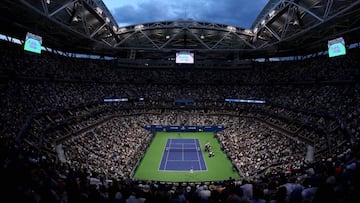One book to read in lockdown: Levels of the Game by John McPhee
John McPhee's account of the 1968 US Open semi-final between Arthur Ashe and Clark Graebner is a stunning achievement in scope and delivery.

Levels of the Game is, on the face of it, a book about tennis. One single game of tennis - the US Open semi-final of 1968 contested by Arthur Ashe and Clark Graebner at Forest Hills - described in minute, point-by-point detail.
It is also a personal history - tracing the roots of Ashe's family back to a slave ship that arrived at Yorktown in 1735 as well as recounting Graebner's childhood - set during the civil rights movement.
John McPhee crafts indelible portraits of Graebner and Ashe. The latter would rise to the top of the game after being tutored by Dr. Robert Walter Johnson, who founded the Junior Development Team for young African-American players. The driving force behind Dr. Johnson's work was to see a black player crowned the USTA interscholastic champion. Ashe went on to win three Grand Slams and has the main show court at Flushing Meadows named in his honour. Graebner, though a fine player, would never lift a major title.
More than anything, Levels of the Game is a skillfully crafted study of the inner workings of two of the top players in the US at the time: Ashe, a Democratic army officer who conversely despises orderliness and Graebner, a strait-laced Republican who cherishes a signed picture of Richard Nixon.
Ashe plays with the "lackadaisical, haphazard manner of a liberal," decides Graebner, whose nickname on the circuit is "Superboy" due to a resemblance to Clarke Kent. McPhee describes him as having a "facial bone structure that suggests heroic possibilities" and who possesses "the posture and presence of a first lieutenant in the Wermacht." Graebner's style is the "stiff, compact tennis of a Republican."
Davis Cup teammates, Ashe and Graebner admired, even liked each other. They placed more importance on winning the Davis Cup as a team than individual triumph at Forest Hills. This relationship is richly painted against the backdrop of the civil rights movement and McPhee interweaves the political panorama of 1960s America into the narrative of the game, seamlessly blending back-story with the immediacy of the tense four-setter.

Ashe vs Graebner story perfectly told
Ashe, with his "narrow, fox-like face" is an enigma. He states that he "might live in Europe for a while" and that Davis Cup ties in Spain give him a chance "to get away from all this crap in the United States." Graebner is a poster boy for conservative elitism, who could have been an "ad for a correspondence course in muscle development."
On court, the two players switch personalities. Ashe, inscrutable, muttering only to himself; Graebner, a scowling presence whose "tell" is the expression on his face as he looks to his wife, former world number four Carole Caldwell, in the crowd . She has her own sign language to cool her husband's temper. Dr. Johnson watches from high in the stands, as unflappable as Ashe himself. "It's a selling point," Ashe says. "I strive to cultivate it. Never betray an inward sense of defeat."
The real triumph of Levels of the Game is McPhee's prose: staccato sentences and paragraphs segue into longer sections, like the rhythm of a tennis match - although by the author's calculation there were just 821 shots played in the game, compared to an average at the time of 2,400. "To put it simply, I just blast the ball back and the point's over," Ashe says. The feared Graebner serve does the rest.
Related stories
As a study of tennis, of the intricacies of a single game and the psychological side of such an individualistic sport, Levels of the Game is unparalleled. The skill with which McPhee describes the mechanics of Ashe's service action in the opening paragraph sets the tone for the entire book. Not unlike Graebner, it is a powerhouse of a construction, every line delivered with the deftness of an Ashe drop shot.
You can buy the book here from Book Depository.
